The Gulf of Tigullio
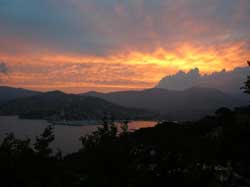 The name of the Gulf derives from the Ligurian tribe of the Tigulli, pre-Roman inhabitants of the Ligurian family. The history of Tigullio has almost always suffered the same fate as the Republic of Genoa. In fact, there have been numerous invasions by pirates in the various coastal villages. In the Middle Ages, political geography divided the region into two blocks: villages allied to the politics of the Genoese republic were created to the west, while the Fieschis dominated in Lavagna.
The name of the Gulf derives from the Ligurian tribe of the Tigulli, pre-Roman inhabitants of the Ligurian family. The history of Tigullio has almost always suffered the same fate as the Republic of Genoa. In fact, there have been numerous invasions by pirates in the various coastal villages. In the Middle Ages, political geography divided the region into two blocks: villages allied to the politics of the Genoese republic were created to the west, while the Fieschis dominated in Lavagna.
Since the walls were present only in Chiavari, in history the Lavagnese counts often tried to cross the border but the intervention of Genoa meant that the Fieschis never managed to obtain the full political majority of Tigullio except when, in the 14th century, they conquered the citadel of Chiavari with the help of the Malaspina , albeit for a short time.
Napoleon rewrote the fate of Genoa and established the Department of the Apennines , electing Chiavari as the capital. After the Congress of Vienna, the Ligurian Republic and the department were dissolved and passed to the Savoy family and, subsequently, to the new Kingdom of Italy in 1861.
Chiavari
The city was officially founded in 1178 but the town already existed during the Iron Age (VIII - VII BC). In history it was the capital of the vicariate and declared a city in 1646, in the nineteenth century Chiavari was an important commercial center for the production of campanine chairs.
To be seen
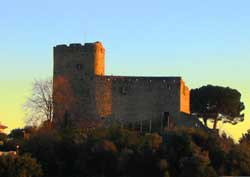 There are many historic buildings in the heart of the medieval city, from Palazzo Ravaschieri (seventeenth century but with a system dating back to the Middle Ages), Palazzo dei Portici Neri , from the XII century, in Piazza Fenice, the late medieval Palazzo Franzone and Palazzo Torriglia with the mannerist marble balconies. , but also the remains of the castle that dominates the city from above, dating back to 1167.
There are many historic buildings in the heart of the medieval city, from Palazzo Ravaschieri (seventeenth century but with a system dating back to the Middle Ages), Palazzo dei Portici Neri , from the XII century, in Piazza Fenice, the late medieval Palazzo Franzone and Palazzo Torriglia with the mannerist marble balconies. , but also the remains of the castle that dominates the city from above, dating back to 1167.
The tower, next to the neo-Gothic Palazzo di Giustizia in Piazza Mazzini, dates back to the 15th century while in the 17th century the Cathedral of Our Lady of the Garden was born as a sanctuary, renovated in the 19th century and which contains many works of art.
Palazzo Rocca , which today houses the Archaeological Museum for Prehistory and Protohistory of Tigullio , was built in the seventeenth century and passed from the Marquises Costaguta to the Grimaldi . Inside the museum, in the stables of the palace, there are the finds of the pre-Roman necropolis discovered at the top of Viale Millo, while in the civic art gallery, on the first floor, paintings of the Genoese baroque are kept.
Next to the cathedral, the Bishop's Palace houses the diocesan museum, while the Palazzo della Società Economica houses the Library, the Risorgimental Historical Museum , the Lorenzo Garaventa Museum and the Cassani - Coppello picture gallery.
The oldest church in Chiavari is that of San Giacomo Rupinaro , dating back to the eighth century but rebuilt in the seventeenth, and finally, the Church of San Giovanni Battista from 1182, but which has been remodeled several times (the facade dates back to 1935) and today it houses a large wooden crucifix by Maragliano and seventeenth-century Genoese paintings.
Santa Margherita Ligure
Santa Margherita was born from the union of the two seaside villages of Pescino and Corte which at the beginning of the nineteenth century took the name of Porto Napoleone , until, after the fall of the emperor, the city took the name of its main church dedicated to the Saint of Antioch.
To be seen
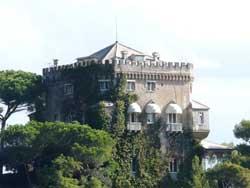 The Basilica of Santa Margherita di Antiochia dates back to the seventeenth century with eighteenth-century paintings and gilded stuccos. Villa Durazzo - Centurione, probably built by Galeazzo Alessi around 1650, dominates the Gulf of Tigullio from above and you can visit both the rooms on the ground floor and the apartments on the main floor; a part instead is the Vittorio G. Rossi Museum , dedicated to the journalist born in Santa Margherita in 1898.
The Basilica of Santa Margherita di Antiochia dates back to the seventeenth century with eighteenth-century paintings and gilded stuccos. Villa Durazzo - Centurione, probably built by Galeazzo Alessi around 1650, dominates the Gulf of Tigullio from above and you can visit both the rooms on the ground floor and the apartments on the main floor; a part instead is the Vittorio G. Rossi Museum , dedicated to the journalist born in Santa Margherita in 1898.
The Church of San Giacomo della Corte , near Villa Durazzo, dates back to the seventeenth century and you can admire its Baroque façade. Finally, near the sea, there is the Church of the Capuchins of the seventeenth century, inside which preserves the Madonna Enthroned, a Provençal statue of the twelfth century.
Rapallo
It is one of the most elegant cities on the Ligurian coast and is the second by population after Genoa. Rapallo is a pearl of the Riviera, with its Art Nouveau buildings, the marina, the villas and the panorama that extends over Portofino , elements that the strong building growth of the last century has not affected.
To be seen
Via Mazzini, via Marsala and via Venezia with their slate portals, are the heart of the historic center, in via Marsala remains one of the five gates that enclosed the city, the Porta delle Saline . The Lungomare Vittorio Veneto recalls the belle epoque with palm trees and Art Nouveau buildings overlooking the sea and, to the west, erected on a rock is the castle, dating back to the sixteenth century, which today is home to exhibitions and events.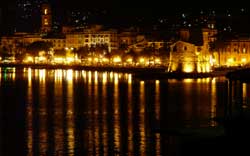 The medieval Hannibal Bridge , which once crossed the Boate River , is located in Corso Cristoforo Colombo and in Piazza delle Nazioni, there is the Church of Santo Stefano rebuilt in the 1600s but dating back to before the year 1000, perhaps the first church in the village .
The medieval Hannibal Bridge , which once crossed the Boate River , is located in Corso Cristoforo Colombo and in Piazza delle Nazioni, there is the Church of Santo Stefano rebuilt in the 1600s but dating back to before the year 1000, perhaps the first church in the village .
Close to Santo Stefano, there are the Civic Tower of 1459 and the Oratorio dei Bianchi from 1600.
In Piazza Cavour there is the Church of Saints Gervasio and Protasio of medieval origin but with renovations of 1753 (bell tower) and 1857 (facade).
The Theater - Auditorium delle Clarisse and the Attilio and Cleofe Gaffoglio Museum are located in the former 17th century convent of the Poor Clares and preserves precious objects, from the 16th to the 20th century, donated by the Gaffoglio to the city.
In Villa Tigullio, in the Casale Park, the Lace Museum houses the collections of bobbin lace, a typical art of Rapallo.
Sestri Levante
The Romans called it Segesta Tigulliorum , since in the land of the Tigulli, it was an important maritime and commercial center. It belonged to the Fieschi di Lavagna after the invasions of the barbarians and passed to Genoa in 1134.
To be seen
Baia delle Favole is a beautiful beach that looks from the Gulf of Tigullio to Portofino and owes its name to Hans Christian Andersen , to whom the international Andersen award is dedicated, which every year receives the most beautiful unpublished fairy tale. Villa Brignole - Balbi today is a hotel and dates back to the seventeenth century.
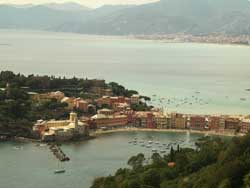 Via XXV Aprile , is the nucleus of the historic center, a long alley with sixteenth-century buildings with slate portals and in Piazza Matteotti there are Palazzo Durazzo - Pallavicini , seat of the Town Hall, and the Parish Church of Santa Maria di Nazareth both seventeenth-century.
Via XXV Aprile , is the nucleus of the historic center, a long alley with sixteenth-century buildings with slate portals and in Piazza Matteotti there are Palazzo Durazzo - Pallavicini , seat of the Town Hall, and the Parish Church of Santa Maria di Nazareth both seventeenth-century.
On the promontory, which was once an island, and on the top of which stands the Torre Marconi where the scientist did his experiments, there is the remarkable Park of the Grand - Hotel dei Castelli , at the border of which stands the Romanesque Church of San Nicolò dell Island with a 15th century façade dating back to 1151. Towards the valley, there are the remains of the late 16th century Oratory of Santa Caterina.
Opposite the Baia delle Favole beyond the promontory, the Baia del Silenzio opens up with the beach and the colorful houses that to the east ends with the Rizzi Gallery with Italian and Flemish works. At the opposite end, immersed in the Mediterranean scrub, is the Convent of the SS. Annunziata of 1467, now home to cultural events.
Portofino
Portus Delphini was probably so called by the Romans because dolphins, protagonists of many myths of these areas, found refuge in its bay.
To be seen
 Today it is an elite tourist destination for famous people all over the world, and its boutiques, bars and restaurants located in the famous Piazzetta are the most expensive in all of Liguria. From the Piazzetta, through via Roma you reach piazza della Libertà, where the road that comes from Santa Margherita Ligure arrives and along which is the fourteenth-century Oratory of Santa Maria Assunta with Gothic elements and a portal from 1555.
Today it is an elite tourist destination for famous people all over the world, and its boutiques, bars and restaurants located in the famous Piazzetta are the most expensive in all of Liguria. From the Piazzetta, through via Roma you reach piazza della Libertà, where the road that comes from Santa Margherita Ligure arrives and along which is the fourteenth-century Oratory of Santa Maria Assunta with Gothic elements and a portal from 1555.
The Church of San Giorgio , overlooking the Capo promontory, houses the relics of the saint, of Romanesque foundation and was rebuilt in 1950. The Brown Castle , re-adaptation of a medieval fortress, purchased in 1870 by the British consul in Genoa (sir MY Brown) , today it belongs to the municipality that has made it a museum of modern art. Beyond the castle you reach the lighthouse on the tip of the Cape.
Camogli
The village of Camogli is located at the western end of the Portofino promontory, on the Paradiso gulf and it seems that the name derives from " camuggi " that is the house of the wives who were waiting for the return of their sailors husbands.
To be seen
The houses of Camogli are perched on the steep hill and the alleys and stairways descend towards the sea, while via Garibaldi allows you to see the Monte di Portofino and the gulf .
On the rock of the island there is the Basilica of Santa Maria Assunta , from the 12th century but with a neoclassical facade, the black and white 17th century churchyard.

The medieval Castel Dragone is located high above the sea and its finds can be found in the Archaeological Museum . Next to the museum, there is the Nicolò Cuneo Library and the Gio Bono Ferrari Maritime Museum , evidence of the maritime importance that Camogli had until the 19th century.
From Camogli, by sea or on foot crossing the Portofino mountain via San Rocco, you reach the splendid and uncontaminated Abbey Complex of San Fruttuoso di Capodimonte , where the ashes of the patron saint of Terragona and the deacons Augurio and Elogio seem to be kept.
The lower part and the church were built by the Benedictines in the 10th century and the upper one in the 12th. In the 13th century, the Dorias built the abbey to make the crypt the family sepulcher. In the 1500s, Admiral Andrea erected the tower and rebuilt the cloister until, in 1861, the Doria family acquired it definitively although it is now in deterioration. Since 1983 it has belonged to the FAI which has made it a museum of the history of the monks and the abbey.